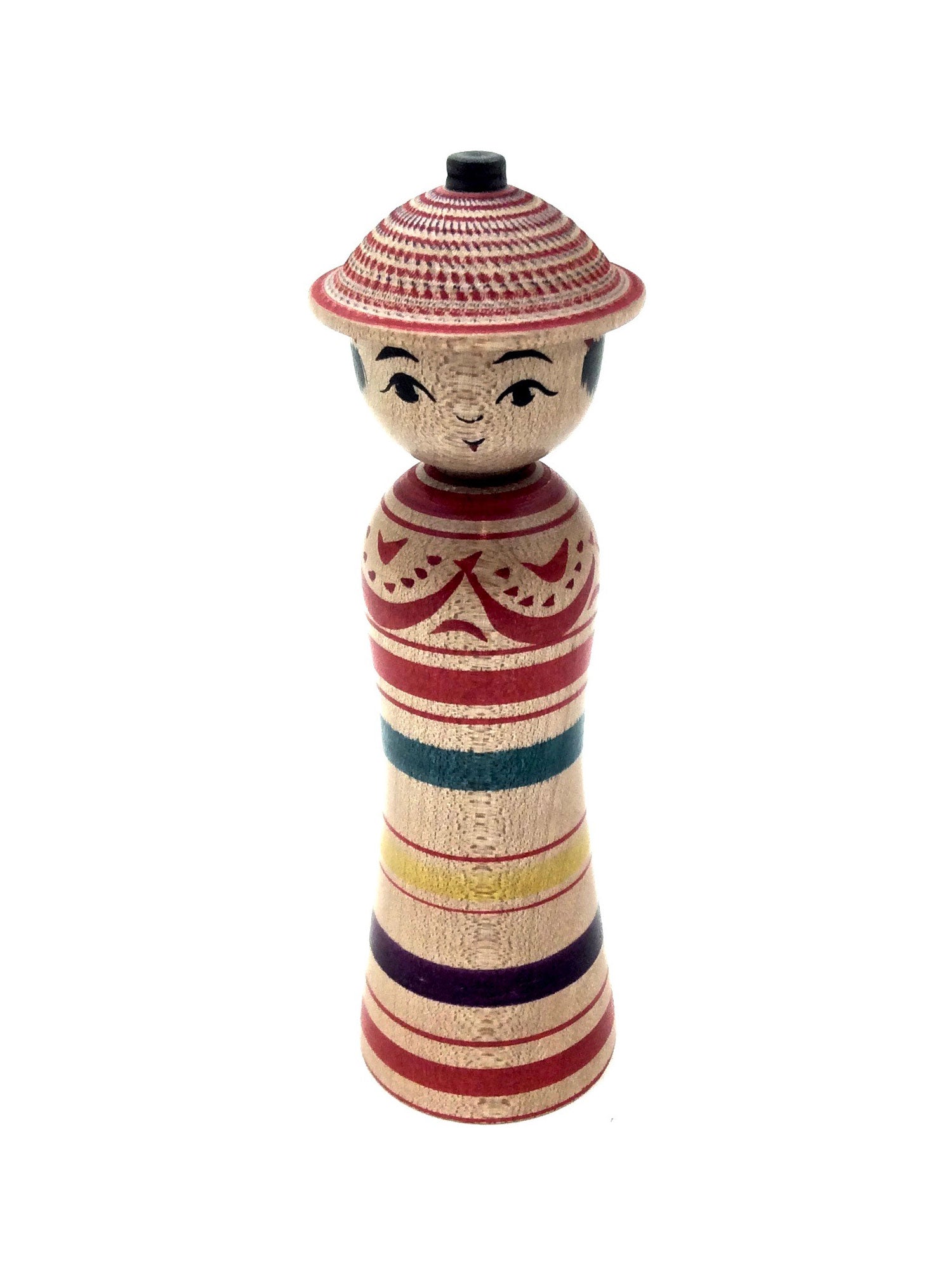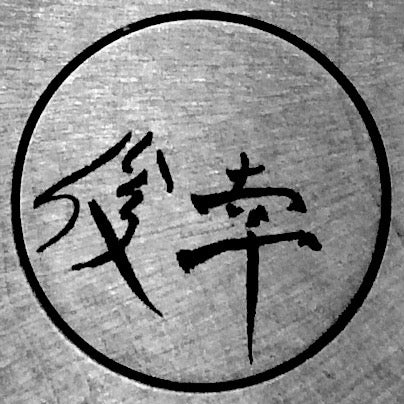

Vintage Tsugaru Traditional Kokeshi by Kitayama, Moriharu
Dimensions: 4-3/4” h
The Tsugaru strain is the newest of the traditional kokeshi. The Tsugaru dolls from the very beginning were mostly made for kokeshi collectors or as souvenirs. One distinguishing feature of this doll is that it has a hat with a top knot in red, with what is finished using “chattering”, to add texture to the hat, with a purple top knot. There is a simple indication of hair on the sides of its face. The doll has an ornamented round chest, thin waist, and tapered lower body with red, green, yellow and purple horizontal line work. It has the Hitoe-Mabuta, (single-lid), eyes and large eyebrows, and a Maru-Bana, (round nose). The piece is signed.
Vintage Condition: The piece is in excellent condition, (“as is”), and retains the original craft/workmanship and is commensurate with age. Any discoloration, chipping/cracking, surface wear, or structural damage is noted.

Japanese Traditional Kokeshi
Tsugaru-Kei (Family)
Prefecture: Aomori
Origin:
Tsugaru is the youngest of the eleven traditional kokeshi strains. They began in the 1920s. A Tsugaru doll has a great deal of variety in its shape and pattern. The Tsugaru Kokeshi are made from a solid piece of wood, created using a difficult reverse lathe technique. The Tsugaru Kokeshi is the only strain to still use this method. The Tsugaru-kei developed after adults took an interest in buying more kokeshi as souvenirs from trips to the hot-spring resorts. Tsugaru dolls, which originated in the Aomori Prefecture in the region of the same name, are sometimes also known as Nuruyu dolls, originally fabricated by Hidetaro Mori. They made their appearance at Nuruyu (“lukewarm") Onsen, in the city of Kuroishi.
Collector's note – characteristics/painting style:
The dolls have round chests, thin waists, and cone-shaped lower bodies on which human faces are painted. They will strike you as quite unusual and interesting. One of the distinguishing features of this family of Kokeshi is a heavier hairstyle, in that most are Okappa styling, which has a full head of hair or mostly full head of hair in a bob style, and a chignon or topknot, without much decoration on the head. The hair is painted solid black, with brush strokes visible on the edges of the bangs and hair. One can easily recognize a Tsugaru doll because many will have the face of Daruma painted on the lower half of the body, with flowers painted on the doll looking quite realistic. The short history of the strain may not yet have given it enough time to utilize flowers such as White irises, peonies, and camellias. Stripes (Rokuro Moyo) appear at the top, center, or bottom of the doll. Some doll motifs, such as Ainu (native designs), that replace the Daruma image have simplified versions of peonies, irises, cherry blossoms, and camellia.
NOTE: We have seen a few dolls with the image of Daruma that were created by Sato, Zenji, (b.1925), in which he drew “feet” on the bottom with his signature, which was inspired by his mentor and master, Mori, Hidetori, (b1895), who used the same interesting humorous addition since kokeshi never incorporated feet.

Leading, Craftsmen:
Abo, Muchihide, 1950, (Hirosaki, Aomori) - Master: Sato, Zenji. No additional published information
Mori, Hidetaro, 1895 (Nuruya, Aomori) - Master: Mori, Motokichi. No additional published information
Mori, Mitsuo, 1955 - Masters: Mori, Hidetaro & Shin-ichi. No additional published information
Muramoto, Fumio, 1941- Master, Mori, Senzo. No additional published information
Okuse, Tetsunori, 1940 - Master: Mori, Hidetaro. No additional published information
Sato, Yoshiki, 1949, (Omani, Aomori) - Master: Mori, Hidetaro. No additional published information
Sato, Zenji, 1925, Master: Mori, Hidetaro. No additional published information
Explore & Learn More about Tsugaru-Kei (Family)